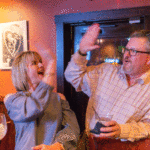VERO BEACH — Although SafeSpace has been providing a safe haven and support to victims of domestic violence in Martin, St. Lucie and Indian River County for the past thirty years, not many people realize that there is a 24-bed state-of-the-art, secure facility in Vero Beach. Its location is kept a secret, for obvious reasons.
In an effort to raise an awareness of the organization and to encourage more people to donate and support the shelter, SafeSpace hosted an “Every Woman is My Sister” luncheon Friday afternoon at the Oak Harbor Club. The special guest speaker was Denise Brown, who became an advocate for victims of domestic violence after the 1994 murder of her sister, Nicole Brown Simpson. Gerri Crawford, Sherry Wilson and Weasy Carmack, who were instrumental in arranging the luncheon, have started a grassroots Friends Group in Vero Beach to help spread the word. Wilson also started “12 Dames of Christmas,” copying a concept that a friend of hers began in Naples. “We make Christmas wishes come true for women and children living in the shelter,” said Wilson. They have also started a speakers group of volunteers and staff who are available to talk to civic groups, churches and other organizations.
SafeSpace board member Bob Schlitt introduced luncheon sponsors, board members and dignitaries and turned the microphone over to Erin Grall who welcomed guests and commended SafeSpace as being the epitome of an unduplicated service in our area.
Grall introduced Denise Brown, who began by saying that it wasn’t until after the murder of her sister that she learned Nicole had suffered from domestic violence throughout their relationship. “I became an advocate for victims because I don’t want others to become a statistic.”
Being less than two years apart in age, the girls grew up with a close bond and remained close even after Denise moved to New York and Nicole moved to Los Angeles.
Denise related that when she first flew out to meet her sister’s new boyfriend, she witnessed an episode that showed his jealous temper. “I wondered why Nicole would stay with a guy who seemed like such a jerk, but I had no idea about the domestic violence.”
After her death, the family found and read Nicole’s diaries and discovered to their horror that there had been 17 years of verbal, emotional and physical violence brutal enough to occasionally warrant hospitalization. “She was living the nightmare so many other women live. If you’re emotionally abused and put down often enough, you start to believe that you’re worthless.”
“SafeSpace is there to help these women. One thing I noticed at the shelters was that they all had smiles because they were safe and they had hope that things would now get better. There is also a huge need for transitional housing where women can learn to live on their own.”
Saying that domestic violence affects everyone in the community, she remarked that it is also a “dirty little secret” that nobody wants to share. “These women don’t want to live that way, but they get caught up in the circle of domestic violence and don’t know where to go for help.”
Brown noted different ways that the community can help, including donating old cell phones, establishing neighborhood watch programs, making financial contributions and by continuing to talk about the issue of domestic violence.
“Just as there are no socioeconomic boundaries to domestic violence it takes everybody working together to end the cycle of violence. If a piece is missing, someone will lose their life.”
The Honorable Diamond R. Litty, Public Defender of the 19th Judicial Circuit closed the luncheon, noting that she had seen the judicial system from every side. “Programs like this save lives. We had 27,000 criminal cases last year, and many of them were domestic violence cases. If it were not for SafeSpace, there would have been many more.”
After the luncheon, I spoke briefly with Art Ciasca, Director of Development for SafeSpace who remarked on the critical need for support. “We are seeing a 57% increase in the need for our services, but at the same time we are facing 15 to 30% cuts in government funding.” {igallery 167}






